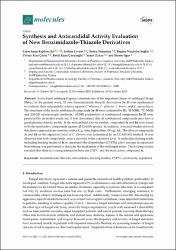Synthesis and Anticandidal Activity Evaluation of New Benzimidazole-Thiazole Derivatives

Göster/
Erişim
info:eu-repo/semantics/openAccessTarih
2017Yazar
Kaplancıklı, Zafer AsımLevent, Serkan
Osmaniye, Derya
Sağlık, Begüm Nurpelin
Çevik, Ulviye Acar
Kaya Çavuşoğlu, Betül
Ilgın, Sinem
Üst veri
Tüm öğe kaydını gösterÖzet
Azole-based antifungal agents constitute one of the important classes of antifungal drugs. Hence, in the present work, 12 new benzimidazole-thiazole derivatives 3a-3l were synthesized to evaluate their anticandidal activity against C. albicans, C. glabrata, C. krusei, and C. parapsilopsis. The structures of the newly synthesized compounds 3a-3l were confirmed by IR, 1H-NMR, 13C-NMR, and ESI-MS spectroscopic methods. ADME parameters of synthesized compounds 3a-3l were predicted by an in-slico study and it was determined that all synthesized compounds may have a good pharmacokinetic profile. In the anticandidal activity studies, compounds 3c and 3d were found to be the most active compounds against all Candida species. In addition, cytoxicity studies showed that these compounds are nontoxic with a IC50 value higher than 500 mu g/mL. The effect of compounds 3c and 3d on the ergosterol level of C. albicans was determined by an LC-MS-MS method. It was observed that both compounds cause a decrease in the ergosterol level. A molecular docking study including binding modes of 3c to lanosterol 14-demethylase (CYP51), a key enzyme in ergosterol biosynthesis, was performed to elucidate the mechanism of the antifungal action. The docking studies revealed that there is a strong interaction between CYP51 and the most active compound 3c.

















